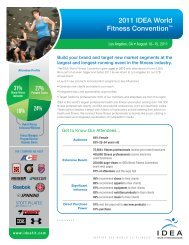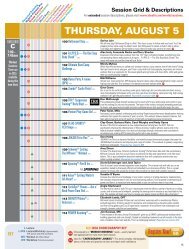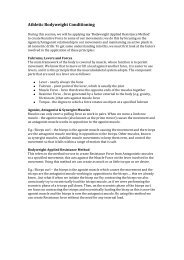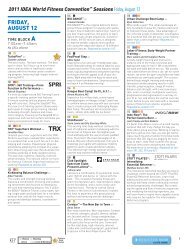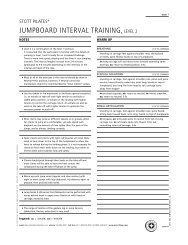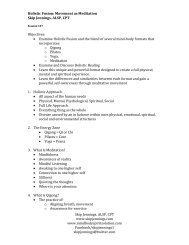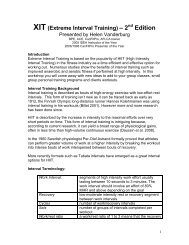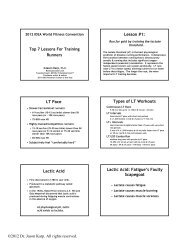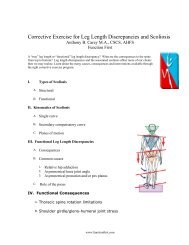Regression to Progression: Strategies For Program Design ... - Idea
Regression to Progression: Strategies For Program Design ... - Idea
Regression to Progression: Strategies For Program Design ... - Idea
- No tags were found...
Create successful ePaper yourself
Turn your PDF publications into a flip-book with our unique Google optimized e-Paper software.
<strong>Regression</strong> <strong>to</strong> <strong>Progression</strong>: <strong>Strategies</strong> <strong>For</strong> <strong>Program</strong> <strong>Design</strong>Chuck Wolf, MS, FAFSHuman Motion Associates1. OverviewI. Tri-Plane Loadinga. Loadb. Stretchc. Absorbd. Deceleratee. EccentricII. Tri-Plane Unloadinga. Unloadb. Shortenc. Propeld. Acceleratee. ConcentricIII.IV. Movement Big Rocksa. Great Toe – does it dorsiflex?b. Ankle Complexi. Calcaneal eversionii.Dorsiflexioniii. Tibial internal rotationiv. <strong>For</strong>efoot abductionV. Common Limitationsa. Limited <strong>For</strong>efoot Abductionb. Tight Great Toec. Tight hip flexors and calf of the same sided. Tight hip flexor and opposite shoulder girdlee. Tight lateral gluteal complexf. Kyphosisg. Tight shoulder girdleVI. Bridging the Gap: Blending Tradition with Integrated Movement Patterns
a. Concentric then eccentricb. Isolate, then integratec. Rotational before lineard. Heavy <strong>to</strong> functional threshold2. Movement <strong>Strategies</strong>I. Ankle Mobesa. Ankle DF with tibial internal rotationb. Ankle DF with opposite shoulder flexionc. Ankle DF with opposite overhead lateral reachd. Step Down <strong>to</strong> ankle DFe. Pivotal Toe TouchesII. Regressive Movement Patternsa. Wall Patternsb. Wall Bangersc. Staggered Stance with feet positioned in various planesIII. Lower Extremity <strong>Progression</strong>sa. Pre-set foot positions with leans in each directionb. Sagittal Plane: long vs. short stancec. Frontal Plane: wide vs. narrow stanced. Transverse Plane: internal vs. external rotation stanceIV. Lunge <strong>Strategies</strong>a. Modified: passive <strong>to</strong> activeb. Self selected lengthc. Lunges with arm drivers in all 3 planes of motionV. Core <strong>Strategies</strong>a. Deep Abdominal Wall Activation I & IIb. Supine Hip Liftsc. Quadruped Stabilization in all 3 planes of motions1. FIAT with various arm drivers, lever lengths & planes2. FIAT in all 3 planes of motion3. ViPR tilts, reaches in all 3 planes4. SLB <strong>to</strong> OH reach with foot on step5. SLB <strong>to</strong> OH reach6. Medball <strong>to</strong>sses in all planes of motion: OH, rotationalii.On-ground progressionsVII. Shoulder Girdle <strong>Strategies</strong>a. Pre-positionb. Type I & II thoracic mobesc. Band Tri-plane cuffd. Tri-plane cuffe. Box Stabilizationsf. Gamesg. Bear crawlh. Pushup Potpourri & On-Ground progressionsVIII. Cervical Spine <strong>Strategies</strong>a. Pre-position
. Type I & II thoracic mobesc. Pre-position with staggered stance lunge with tri-plane OH reachfor relative C-spine motiond. Tri-Plane shoulder press: no weights <strong>to</strong> light weightse. Triangulated shoulder press3. Sports Performance: Return <strong>to</strong> PlayI. Movement Prepa. Wall Drillsb. Arm Swingsc. High Kneesd. Butt Kickse. Long StridesII. Agility Patternsa. T, L, V, W Patternsb. Lateral Hurdlec. Stick <strong>to</strong> sprintd. Hurdle Hopse. Circle Circuitf. Shuttle Sprint Circuitg. Base Positionh. Crossoveri. Line DrillsReferencesCarlsoo, Sven, How Man Moves, 1972, London, William Heinemann Ltd.Clark, M.A., “Integrated Flexibility Training”, Thousand Oaks, Ca., National Academyof Sports Medicine, 2001Dykyj, Daria, Ph.D., “Ana<strong>to</strong>my of Motion”, Clinics in Podiatric Medicine and Surgery,July 1988, Vol. 5, No. 3Gray, Gary, P.T., “Pronation and Supination”, Wynn Marketing, Adrian, Michigan,2001www.wynnmarketing.com,Gray, Gary, P.T., “Functional Biomechanics: Pure Definitions”, Wynn Marketing,Adrian, Michigan, 2001www.wynnmarketing.com,Inman, Verne, Human Walking, Williams & Wilkins, 1981Katch, Frank, Katch, Vic<strong>to</strong>r L., McArdle, William D., Exercise Physiology: Energy,Nutrition, and Human Performance, 1986, Philadelphia, Lea & FebigerMasson, Dr. Robert, Neurospine Institute, Ocoee, FL. www.Neurospineinstitute.orgPowers, Scott K. & Howley, Edward T., Exercise Physiology: Theory and Application <strong>to</strong>Fitness and Performance, 1990, Dubuque, Iowa, Wm. C. Brown PublishersSchamberger, Wolf, The Malalignment Syndrome, Churchill Livings<strong>to</strong>ne, 2002Simon, Sheldon, MD, Mann, Roger, MD, Hagy, John, O.R.E., Larsen, Loren, MD, “Role
of the Posterior Calf Muscles in Normal Gait”, Journal of Bone and Joint Surgery, June1978, Vol. 60-A, No. 4Prestige Cervical Core Education Course, Medtronics, 2007



